Connector Technology Highlights from DesignCon
Bob Hult reports on the connector technology highlights from DesignCon, especially the race to 100+Gb/s.
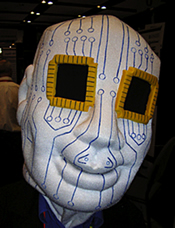 The DesignCon 2014 conference and expo once again demonstrated the event’s value as the premier showcase for high-speed chip, connector, and PCB board technology. Featuring a full schedule of well-attended technical sessions over four days, a sense of excitement and momentum was evident at this year’s event. Attendance appeared to be up, with heavy booth traffic at the expo throughout the show, as attendees examined connector technology highlights up close. Technical seminars addressed chip, board, simulation, test, and interconnect challenges posed by 25+Gb/s channels.
The DesignCon 2014 conference and expo once again demonstrated the event’s value as the premier showcase for high-speed chip, connector, and PCB board technology. Featuring a full schedule of well-attended technical sessions over four days, a sense of excitement and momentum was evident at this year’s event. Attendance appeared to be up, with heavy booth traffic at the expo throughout the show, as attendees examined connector technology highlights up close. Technical seminars addressed chip, board, simulation, test, and interconnect challenges posed by 25+Gb/s channels.
Eye on 100+Gb/s
In contrast to DesignCon 2013, where 10Gb/s channels were just beginning to be achieved and 25Gb/s was the expected future target, many papers this year outlined the road to 100+Gb/s links. Multiple connector suppliers demonstrated 25Gb/s to 36Gb/s interconnect systems. Design engineers now have the option of utilizing a variety of architectures, including traditional backplane, midplane, orthogonal midplane, orthogonal-direct midplane, and cable backplanes. Orthogonal midplane-direct offers the shortest signal path length between daughtercards, but requires accurate alignment mechanisms to ensure proper mating. Cable backplane systems enable extended lengths between daughtercards, but pose significant cable management challenges. Molex demonstrated a 28Gb/s board-to board link over six meters of shielded twin-axial cable. The Amphenol booth included a 32Gb/s channel over 20 inches of Megtron 6 PCB material. The question of exactly how far a 25Gb/s signal can be cost-effectively transmitted on copper depends on who you talk to, and varies between 20 to 40 inches. Confidence that practical 25+Gb channels can be designed and built in production quantities replaced the skepticism that was evident last year.
Power connectors continue to be upgraded with current ratings that run to 100+ amps per contact. A combination of thicker contact materials using higher conductivity copper alloys, improved plating, new contact designs, and vented housings enable higher published current ratings.
Optical Interconnects
Optical interconnects continue to draw interest as component costs decrease and 25+ Gb/s systems proliferate. An increasing number of leading connector manufacturers are hedging their bets by investing in alternatives to traditional copper interfaces to ensure they will be ready with the most cost-effective solution as data rates continue to ratchet up. Many cable suppliers featured a variety of passive and active optical cable assemblies. Mid-board optical engines that take high-speed signals off the board and transport them optically were featured by several suppliers, with more to come. Advances in silicon photonics promises to bring optics to inside-the-box applications. The battle for high-speed I/O interfaces is being defined by multiple standards, such as zQSFP+, HD4, zCD, CDFP, and CFP4 using passive and active copper and fiber media.
New Product Introductions
DesignCon has historically been a showcase of new product introductions, and this year was no exception. With more than 24 manufacturers of connectors and cable assemblies exhibiting, suppliers demonstrated how next-generation equipment will be capable of achieving even higher performance goals.
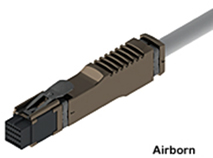 Drawing on its years of experience in high-reliability military and avionic interconnects, AirBorn demonstrated its HD4 I/O interconnect system, which provides eight differential pairs operating at up to 10Gb/s and consuming less than half the space of a QSFP connector. Connectors can be ganged for even higher panel density.
Drawing on its years of experience in high-reliability military and avionic interconnects, AirBorn demonstrated its HD4 I/O interconnect system, which provides eight differential pairs operating at up to 10Gb/s and consuming less than half the space of a QSFP connector. Connectors can be ganged for even higher panel density.
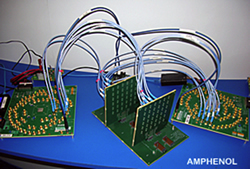
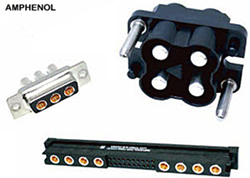 The Amphenol booth featured a wide variety of high-performance interconnects, including a demonstration of 25Gb channels over a traditional backplane, 28Gb channels over 1.6 meters of a twin-axial cable backplane, and 32Gb over 20 inches of Megtron 6 PCB backplane using its XCede backplane connector. Amphenol also featured its CoolPower family of power connectors that utilize RADSOK technology for increased power ratings to 250A per contact.
The Amphenol booth featured a wide variety of high-performance interconnects, including a demonstration of 25Gb channels over a traditional backplane, 28Gb channels over 1.6 meters of a twin-axial cable backplane, and 32Gb over 20 inches of Megtron 6 PCB backplane using its XCede backplane connector. Amphenol also featured its CoolPower family of power connectors that utilize RADSOK technology for increased power ratings to 250A per contact.
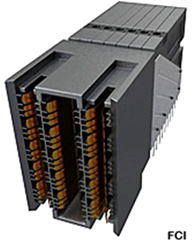 FCI Electronics introduced three new products in the high-speed backplane and power connector segments:
FCI Electronics introduced three new products in the high-speed backplane and power connector segments:
- The ExaMAX direct-mate orthogonal connectors, which are rated to 25Gb/s with a migration path to 40Gb/s, received the DesignVision award for 2014. Connectors in this family of interfaces are now available in two-, three-, four-, and six-pair versions and feature unique “stubless” hermaphroditic beam-on-beam contacts to ensure superior signal integrity, as well as exceptionally low mating forces. When teamed with the FCI ExaMEZZ stacking connector, systems compliant with OIF-25G-LR can be designed and built.
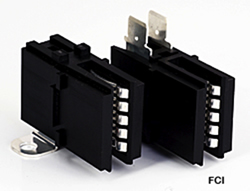 The PwrBlade ULTRA connector is the latest addition to the PwrBlade family of power interconnects. The ULTRA version features a 9.6mm reduced height to minimize obstruction to cooling airflow. High-power contacts are rated to 70A each, with low-power contacts rated 35A for design flexibility. Connectors support right-angle as well as co-planar applications.
The PwrBlade ULTRA connector is the latest addition to the PwrBlade family of power interconnects. The ULTRA version features a 9.6mm reduced height to minimize obstruction to cooling airflow. High-power contacts are rated to 70A each, with low-power contacts rated 35A for design flexibility. Connectors support right-angle as well as co-planar applications.- The Right-Angle BarKlip connector is designed to mate directly with a bus bar and features 10 independent points of contact for low resistance. The contacts are designed for loads of up to 150A each and feature new AGT tarnish-resistant silver plating that improves the durability as well as appearance of traditional silver plating.
The Integrated Solutions business unit of HARTING featured its extensive high-speed backplane design, modeling, simulation, verification, and fabrication capabilities. In addition to development of custom backplanes, HARTING has extensive experience building backplanes defined by industry standards including PICMG and ATCA, as well as VITA VXS and VPX. It currently has the capability of testing boards to 40Gb/s with plans to expand to support 100Gb/s channels.
 Hirose is constantly upgrading its extensive line of high-speed mezzanine connectors. The IT5 Series is now rated to 25Gb/s and features stack heights that range from 18 to 40mm. Samtec is a fully licensed second source for this connector family.
Hirose is constantly upgrading its extensive line of high-speed mezzanine connectors. The IT5 Series is now rated to 25Gb/s and features stack heights that range from 18 to 40mm. Samtec is a fully licensed second source for this connector family.
Hirose introduced the IT-P board-to-board power pin connector, which is also based on its unique three-piece assembly for design flexibility. The 60A contacts are on a 12mm pitch and are rated to 300V AC/DC. These power connectors are designed to be compatible with IT3 and IT5 high-speed mezzanine connectors.
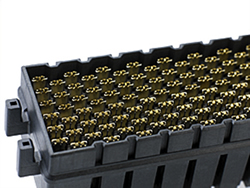
Molex featured several new interfaces, including the NeoScale high-speed/high-density mezzanine connector. Designed to perform to 28+Gb/s, modular NeoScale connectors utilize a unique triad wafer design that delivers exceptionally clean signals with the ability to mix application-specific combinations of 85Ω and 100Ω signals. Connectors are terminated to the board using Molex’s patented Solder-Charge technology. Connectors are available in stacking heights of 12 to 42mm in circuit sizes of eight to 300 contacts.
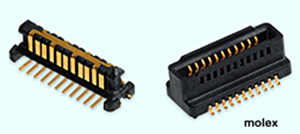 The Molex SpeedStack mezzanine connector takes bandwidth to the next step with its rating to 40Gb/s data rates. The design of this connector has been optimized for airflow, high speed, and signal density. Six to 32 differential pair contacts are on a 0.8mm pitch with stack heights up to 10mm. Both 85Ω and 100Ω versions have been tooled.
The Molex SpeedStack mezzanine connector takes bandwidth to the next step with its rating to 40Gb/s data rates. The design of this connector has been optimized for airflow, high speed, and signal density. Six to 32 differential pair contacts are on a 0.8mm pitch with stack heights up to 10mm. Both 85Ω and 100Ω versions have been tooled.
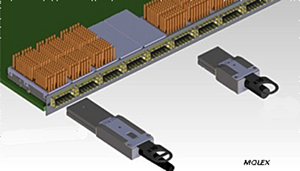 The zCD connector is the latest contender for a high-speed and high-density pluggable I/O interface. This system is capable of transmitting 400Gb/s (25Gb/s over 16 lanes). Short-body versions are designed for passive or active copper cables while a long-body version will support active optical cables or transceivers. Connectors are hot-pluggable and fully shielded for EMI suppression. Molex and TE are active members of the CDFP MSA, which is focused on promoting transmission of 400Gb/s signaling using the CDFP form factor.
The zCD connector is the latest contender for a high-speed and high-density pluggable I/O interface. This system is capable of transmitting 400Gb/s (25Gb/s over 16 lanes). Short-body versions are designed for passive or active copper cables while a long-body version will support active optical cables or transceivers. Connectors are hot-pluggable and fully shielded for EMI suppression. Molex and TE are active members of the CDFP MSA, which is focused on promoting transmission of 400Gb/s signaling using the CDFP form factor.
Molex also showed its expanded Edge-Line high-speed edge-card connector, which is rated up to 25Gb/s. This cost-effective connector accepts a range of PCB thicknesses, and is terminated to the board via standard press-fit or surface-mount processes.
Samtec displayed its extensive line of high-density board-to-board connectors, including the SEARAY mezzanine family, which is now rated to 28+Gb/s. Rather than modify the connector, Samtec has extended its “Final Inch” connector footprint concept to include design guidelines for the entire channel to ensure signal integrity. In order to provide a higher level of support, Samtec demonstrated its Solutionator website, which allows the designer to select any Samtec connector, plug in a series of application-specific circuit parameters, and immediately receive 3-D connector drawings, insertion loss, return loss, NEXT, and FEXT data, as well as a complete set of S parameters and eye diagrams for the channel. If the results of the simulation look good, samples of the connectors can be ordered.
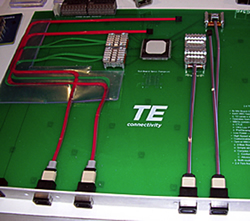 TE Connectivity featured a wide array of interconnects spanning power to high-speed signal and copper to fiber optics. A demonstration of a cable backplane utilized its flagship STRADA Whisper connector, terminated in two meters of twin-axial cable running at 25Gb/s.
TE Connectivity featured a wide array of interconnects spanning power to high-speed signal and copper to fiber optics. A demonstration of a cable backplane utilized its flagship STRADA Whisper connector, terminated in two meters of twin-axial cable running at 25Gb/s.
Responding to ongoing interest in fiber optic alternatives to copper, TE showed a developmental mid-board optic transceiver that terminates 24 fibers to an MT ferrule. The transceiver provides 12 channels operating at 25Gb/s each to deliver up to 300Gb.
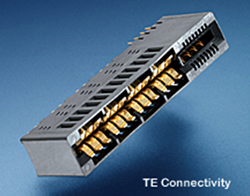 Demand for increased power management continues to spur the introduction of new power connectors that closely match the requirements of individual applications. TE introduced two new extensions of its MultiBeam power connector family, the MultiBeam High Density (HD) and MultiBeam CardEdge Connector (CE) versions. The HD connector features more efficient use of PCB real estate while achieving a lower voltage drop. The CE connector combines low profile and cost.
Demand for increased power management continues to spur the introduction of new power connectors that closely match the requirements of individual applications. TE introduced two new extensions of its MultiBeam power connector family, the MultiBeam High Density (HD) and MultiBeam CardEdge Connector (CE) versions. The HD connector features more efficient use of PCB real estate while achieving a lower voltage drop. The CE connector combines low profile and cost.
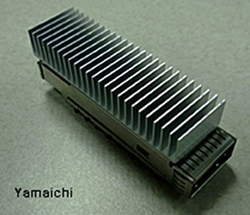 Yamaichi has been a leading proponent of the CFP pluggable optical module form factor. It featured its CFP4/QSFP28 copper cable assemblies in lengths to seven meters for short-reach 100Gb/s applications.
Yamaichi has been a leading proponent of the CFP pluggable optical module form factor. It featured its CFP4/QSFP28 copper cable assemblies in lengths to seven meters for short-reach 100Gb/s applications.
DesignCon 2014 clearly demonstrated that data rates will continue to increase over the coming years. The technical challenges are recognized by the industry, and the tools necessary to support these rates are in the pipeline.
Robert Hult, Market Director, Bishop & Associates, Inc.
- Digital Lighting Enhances your Theatrical Experience - March 5, 2024
- DesignCon 2024 in Review - February 13, 2024
- Chip Technology Struggles to Keep Pace with Moore’s Law - January 30, 2024







